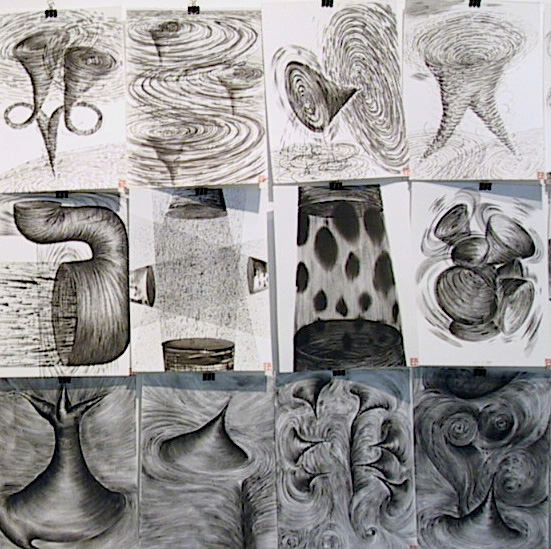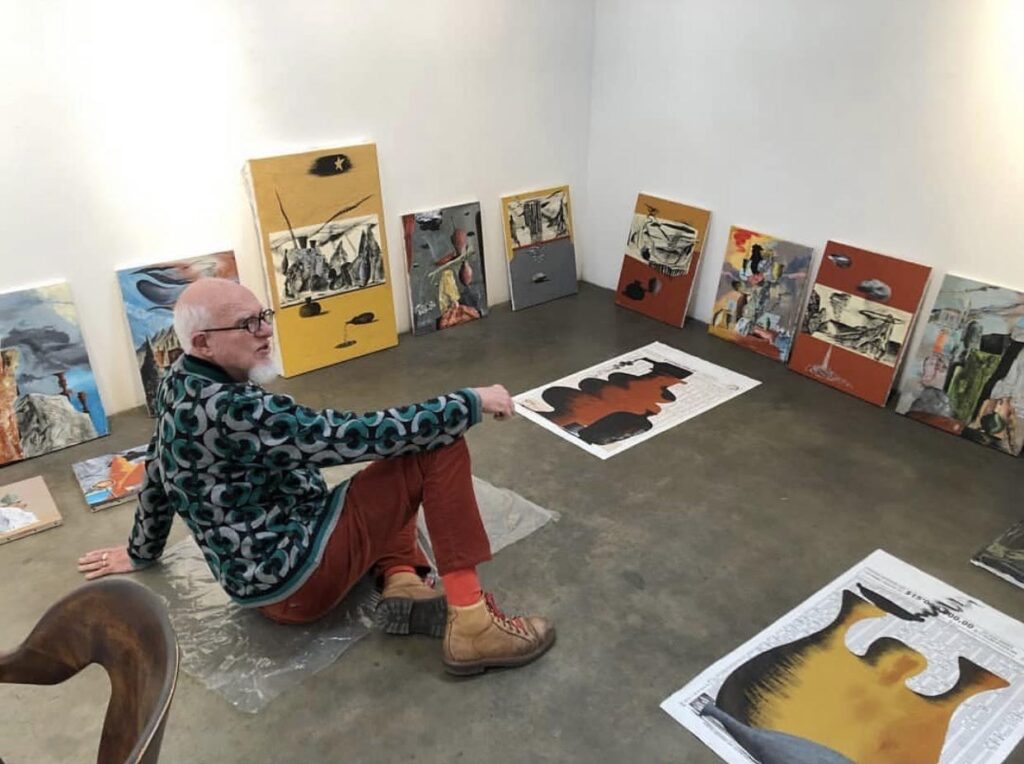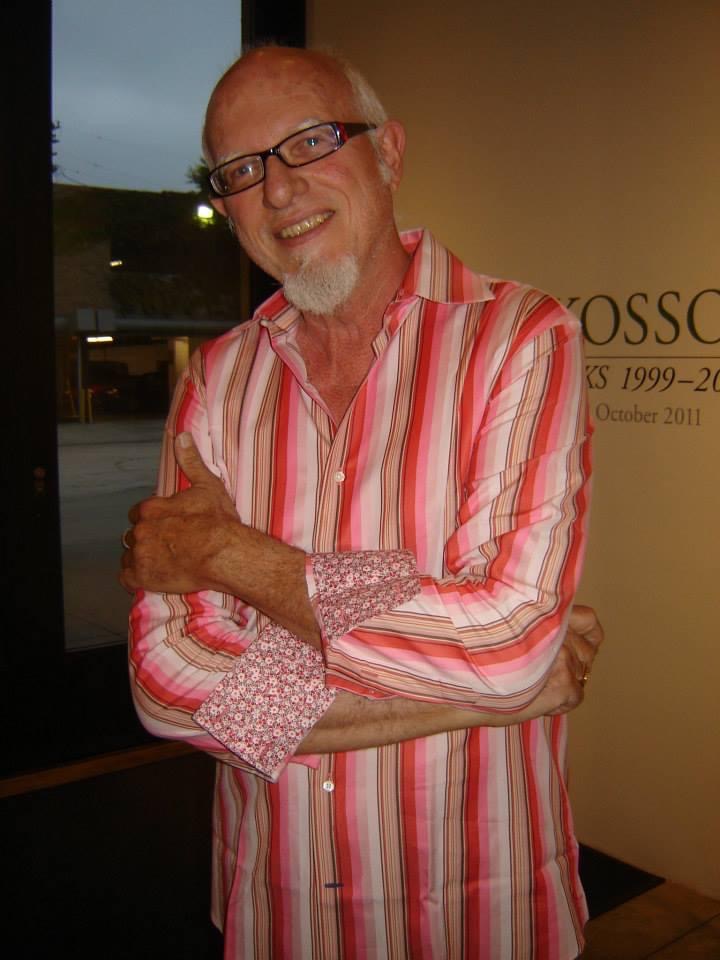
Pierre Picot was a Franco-American artist who spent his childhood in Paris and his adolescence and adulthood in Los Angeles. As an immigrant, having experienced this dramatic shift in cultures and environments at a formative age, he often described his working process as a way of seeking home. A flaneur by nature, his spiritual home was always in his work, whether he worked at his dining room table, in a sprawling studio, on his travels, or walking in the forest.
As an undergraduate art student at UCLA in the late 60’s, he studied with Ed Ruscha, William Brice, and Lee Mullican. He spent his free time attending the films shown there, which had a major influence on his work.
At CalArts Graduate School in the legendary early 70’s, he decided to approach Fine Art from the side, getting his Masters in Graphic Art while creating and participating in performance pieces with his Fine Arts brethren.
His “outsider” approach can be seen in the work he became known for in the 80’s. His shows of paintings made from painted cardboard cutouts, with wry titles and subjects and a strong graphic quality, sold out at the Jan Baum Gallery. As he said, he was doing “the right work at the right time.” His work from this period is considered to be part of a kind of neo-expressionist movement populated by young artists in Los Angeles at that time, and his work was in some landmark group shows. During this period he was also writing for art publications and catalogs, as well publishing a free newspaper in a visionary format, Art in LA, that he distributed at the fledgling Los Angeles Contemporary Art Fair for four years.
He was comfortable with and adept at working in any scale and material according to the shape his ideas were taking in his mind, where he insisted that most of his work was being done — which belies his his extraordinary technical skills.

He always made scads of drawings and small paintings in preparation for his large paintings, which were often six feet tall and/or wide. His mastery of mark-making was obsessive and inventive, as he explored myriad ways to make his imagined images concrete. At a private showing of his 350 drawings, “Ecstatic Manifestations of the Physical Universe,” his friend Charles Garabedian (himself a legendary and prolific painter) asked him, “Just how do you DO that?”
Landscape elements had always found their way into his work, but during a 2006 stint as a Professor at the Pont Aven School of Contemporary Art, based in the French village that Paul Gaugin made famous, he discovered the “Bois d’Amour” where Gaugin had cavorted with his artist friends. It was his first daily experience in a lush forest, and having only had Southern California as his reference point for Nature, it was an epiphany.
He made pencil and watercolor sketches every day, walking back and forth to school through the forest, sometimes using raindrops to moisten his brush. His artwork thereafter was transformed, and he created a large body of work using Chinese black ink which reflects his profound response to the grandeur of the forest.

He was a particularly perspicacious teacher in Fine Arts Programs around Los Angeles (Claremont, UCLA, USC, Otis, and for many years at Art Center) from the 1980’s until 2012. He was known for his wide-ranging references and projects, and had a unique facility for teasing out hidden interests, capabilities, and talents of his students.
His unusual teaching style included field trips (The Salton Sea, Watts Towers, Gemini GEL), films (Mon Oncle, Funny Face, La Jetée), literature (Against the Grain), and visual and thematic references to known and unknown artists. These seemingly simple things were revelations to his students, many of whom had not explored Los Angeles, nor seen a foreign film, nor dug into the offerings of the school library, where he often took his classes (requiring them to look at and take home books almost at random).
Artist Soloman Huerta wrote this tribute to Pierre recently:
“Many moons ago, I was an illustration major at ArtCenter College of Design in Pasadena doing commercial art, until I took Pierre Picot’s fine art class. While I was looking at a book on Edward Manet, Pierre asked me, “Why don’t you paint your neighborhood friends in Manet’s style?” So I did several paintings of homeboys from my neighborhood in East Los Angeles’ notorious public housing projects. From that point (to the present), I pursued fine art.”
There was a conspicuous lack of emphasis on technique in his classes (“they can learn that anywhere”). Instead, there was an insistence on the exploration of meaningful personal subject matter. Examples of this would be “paint something you LOVE” or “paint something you HATE”.
His generosity towards other artists was a kind of personal mission. As a student, artist Cole Case recollects finding a signed sticky note on a painting of his in a common space in at Art Center: “He didn’t know me, I wasn’t in his class but I found a sticky note on my painting that said ‘this is great work’. Who does that?”
He always felt a deep kinship with other artists. He strongly responded to what he perceived as the “obsessiveness” of Outsider Artists, and had a particular interest in artists he felt had been overlooked by Art History because of their sexual orientation, eccentricities, or art-world expectations at particular moments. He created a lecture series entitled Obscurity/Genius to redress this imbalance, which was offered as a class at Art Center and at the Otis Graduate School.
In 2012 he moved to Brittany, France, with his Shoe Designer wife Wendy Holden, where they rented a wing of an 18th Century chateau, and where he died in 2021. He leaves behind a rich body of work — drawings, paintings, objects, notebooks, furniture, and ephemera — and lives on in the memories of artists, friends, collectors, fans, and students, always struck by his work, his insight, generosity, curiosity, and enthusiasm, as well as his unique style of dress and wide range of knowledge about art and artists from myriad eras.

“I have no strategy … intentions and results somehow manage to eventually add up to a concise whole, finding their coherence in the make up of their individual parts.
I know that my personal beliefs and the way in which they find some sort of public expression come together almost by accident. One thing follows the other, through some undefined inner logic, but certainly not through a conscious and objective rationale.
I ask myself some questions, do some research, watch a movie, set up guidelines, get an ice cream, ask the opinion of others, read a book, take some time off to go earn a living, incorporate stimulation from aspects of play and work, while seeking out answers which will eventually make sense … or not … and if not now, then eventually later.
This is not to say that I am relaxed, casual, easygoing, living in the moment, sipping away on my tropical drink (the one with the little umbrella) and playing the fiddle while Rome burns, which of course it is … burning.”
Pierre has been represented by the Craig Krull Gallery since 2014.